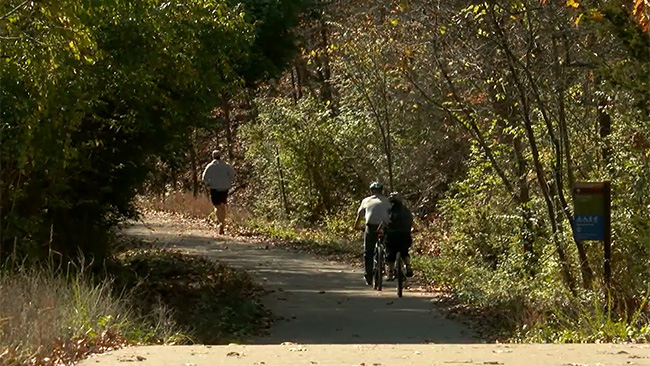Facing Repeated Flooding, Missouri Finds Ways to Lighten Damage
Along rivers and statewide, floodplain preservation offers many benefits to communities

Vegetation lining the Meramec River Greenway, in St. Louis County, Missouri, slows down and absorbs floodwaters, helping boost the area’s resiliency to natural disasters.
This American Land
Eight of the 10 states that experienced the most flood-related disaster declarations over the past decade were inland. Near the top of the list sits Missouri, a state that has endured repeated and devastating riverine flooding, and not just in the past decade: From 2000 to 2017, the federal government issued 25 disaster or emergency declarations for floods, hurricanes, and severe storms in the state. The most recent of those came a year ago this week, when massive flooding struck Missouri, Illinois, and Arkansas. Floodwaters left 20 people dead and caused $1.7 billion in damage to homes, businesses, farms, and infrastructure.
The challenge of frequent and costly flooding in Missouri, and what communities there are doing in response, is the topic of an upcoming episode of “This American Land,” a public television series commissioned by The Pew Charitable Trusts to showcase environmental issues.
Over the past three decades, St. Louis County, which borders numerous waterways, has aggressively restored and connected natural space and wetlands along 108 miles of the Meramec River; many of those areas had been degraded by recurring floods. Those improvements provide long-term economic benefits, according to an independent nonprofit group, Resources for the Future. The group found that by protecting—instead of developing—the Meramec River Greenway, St. Louis County is projected to save an average of $7.7 million in avoided flood damage every year, while having the potential to create about $23.6 million annually in recreational and aesthetic value.
Federal assistance has been key to helping Missouri communities become more resilient. With support from the Federal Emergency Management Agency’s Hazard Mitigation Grant Program (HMGP), Missouri’s state government conducted buyouts from willing homeowners in flood-prone areas that saved nearly $100 million from losses avoided in 2008, a 212 percent return on investment.
Missouri has shown that it takes a multifaceted approach to address rising waters and that floodplain conservation can help reduce riverine flooding and provide quality-of-life benefits that ripple throughout a region. Watch the short “This American Land” story here to see how community leaders, conservationists, and government officials work together on ways to break the costly cycle of flooding and rebuilding.
Laura Lightbody directs Pew’s flood-prepared communities initiative.


Before the Flood: The Value of Mitigation
There’s much that governments can do to lessen the impact of the natural disasters that are becoming increasingly common.


After the Storm: Charleston’s Blueprint


The Financial Toll of Flooding—Part 1
Episode 8







